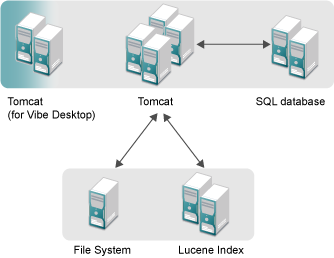A.6 Very Large Installation

This deployment is suitable for a large business. This deployment uses load balancing across all servers. The database server is separate, to increase the amount of parallel processing in the system. The index server is separate, to allow the application to better utilize the physical memory that is allocated. The file system is separate, and a SAN file system is recommended. The memory utilization of the index server is proportional to the index size, which is directly related to the number and size of documents and entries that are stored. As the number and size of documents and entries that are stored increases, you should increase the amount of memory accordingly. If Vibe Desktop is being used with more than 100 active users, it must be running on multiple separate Vibe (Tomcat) servers.
|
Vibe Components |
CPU |
Memory |
Java Heap |
|---|---|---|---|
|
Multiple Vibe servers:
|
3Ghz x64 quad-core or 8-core |
4–8 GB |
6 GB |
For more information on load balancing, see Configuring a Web Application to Provide High Availability Functionality for Your Vibe Site.
For information on how to create a separate Vibe database, follow the instructions specific to your database type, as described in Section 19.0, Creating the Vibe Database on a Separate Server.
For information on how to create a separate index server, see Section 20.0, Installing the Lucene Index Server on a Separate Server.
For more information on how to create a separate file system server, see Vibe File Repository Considerations.
For more information on how to configure Vibe Desktop to run on your Vibe server, as well as how to distribute Vibe Desktop synchronization traffic to a dedicated Vibe server, see Providing File Access and Editing for Vibe Users
in VibeSite Setup
in the OpenText Vibe 4.0.8 Administration Guide.
You must perform an Advanced installation to achieve this type of deployment. For more information, see Section IV, Advanced Installation and Reconfiguration.